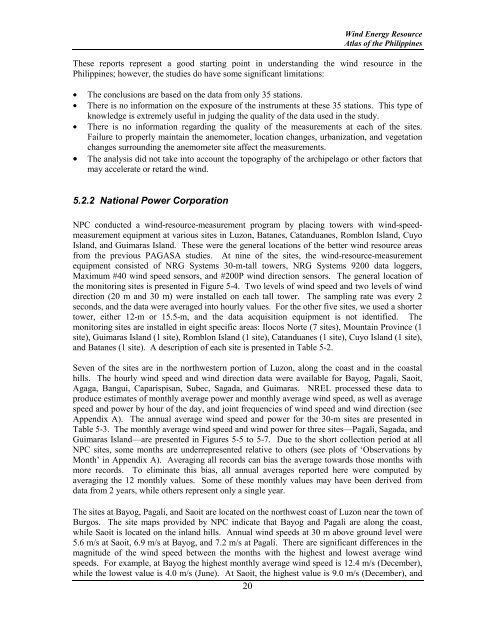Wind Energy Resource Atlas of the Philippines - NREL
Wind Energy Resource Atlas of the Philippines - NREL
Wind Energy Resource Atlas of the Philippines - NREL
Create successful ePaper yourself
Turn your PDF publications into a flip-book with our unique Google optimized e-Paper software.
<strong>Wind</strong> <strong>Energy</strong> <strong>Resource</strong><br />
<strong>Atlas</strong> <strong>of</strong> <strong>the</strong> <strong>Philippines</strong><br />
These reports represent a good starting point in understanding <strong>the</strong> wind resource in <strong>the</strong><br />
<strong>Philippines</strong>; however, <strong>the</strong> studies do have some significant limitations:<br />
• The conclusions are based on <strong>the</strong> data from only 35 stations.<br />
• There is no information on <strong>the</strong> exposure <strong>of</strong> <strong>the</strong> instruments at <strong>the</strong>se 35 stations. This type <strong>of</strong><br />
knowledge is extremely useful in judging <strong>the</strong> quality <strong>of</strong> <strong>the</strong> data used in <strong>the</strong> study.<br />
• There is no information regarding <strong>the</strong> quality <strong>of</strong> <strong>the</strong> measurements at each <strong>of</strong> <strong>the</strong> sites.<br />
Failure to properly maintain <strong>the</strong> anemometer, location changes, urbanization, and vegetation<br />
changes surrounding <strong>the</strong> anemometer site affect <strong>the</strong> measurements.<br />
• The analysis did not take into account <strong>the</strong> topography <strong>of</strong> <strong>the</strong> archipelago or o<strong>the</strong>r factors that<br />
may accelerate or retard <strong>the</strong> wind.<br />
5.2.2 National Power Corporation<br />
NPC conducted a wind-resource-measurement program by placing towers with wind-speedmeasurement<br />
equipment at various sites in Luzon, Batanes, Catanduanes, Romblon Island, Cuyo<br />
Island, and Guimaras Island. These were <strong>the</strong> general locations <strong>of</strong> <strong>the</strong> better wind resource areas<br />
from <strong>the</strong> previous PAGASA studies. At nine <strong>of</strong> <strong>the</strong> sites, <strong>the</strong> wind-resource-measurement<br />
equipment consisted <strong>of</strong> NRG Systems 30-m-tall towers, NRG Systems 9200 data loggers,<br />
Maximum #40 wind speed sensors, and #200P wind direction sensors. The general location <strong>of</strong><br />
<strong>the</strong> monitoring sites is presented in Figure 5-4. Two levels <strong>of</strong> wind speed and two levels <strong>of</strong> wind<br />
direction (20 m and 30 m) were installed on each tall tower. The sampling rate was every 2<br />
seconds, and <strong>the</strong> data were averaged into hourly values. For <strong>the</strong> o<strong>the</strong>r five sites, we used a shorter<br />
tower, ei<strong>the</strong>r 12-m or 15.5-m, and <strong>the</strong> data acquisition equipment is not identified. The<br />
monitoring sites are installed in eight specific areas: Ilocos Norte (7 sites), Mountain Province (1<br />
site), Guimaras Island (1 site), Romblon Island (1 site), Catanduanes (1 site), Cuyo Island (1 site),<br />
and Batanes (1 site). A description <strong>of</strong> each site is presented in Table 5-2.<br />
Seven <strong>of</strong> <strong>the</strong> sites are in <strong>the</strong> northwestern portion <strong>of</strong> Luzon, along <strong>the</strong> coast and in <strong>the</strong> coastal<br />
hills. The hourly wind speed and wind direction data were available for Bayog, Pagali, Saoit,<br />
Agaga, Bangui, Caparispisan, Subec, Sagada, and Guimaras. <strong>NREL</strong> processed <strong>the</strong>se data to<br />
produce estimates <strong>of</strong> monthly average power and monthly average wind speed, as well as average<br />
speed and power by hour <strong>of</strong> <strong>the</strong> day, and joint frequencies <strong>of</strong> wind speed and wind direction (see<br />
Appendix A). The annual average wind speed and power for <strong>the</strong> 30-m sites are presented in<br />
Table 5-3. The monthly average wind speed and wind power for three sites—Pagali, Sagada, and<br />
Guimaras Island—are presented in Figures 5-5 to 5-7. Due to <strong>the</strong> short collection period at all<br />
NPC sites, some months are underrepresented relative to o<strong>the</strong>rs (see plots <strong>of</strong> ‘Observations by<br />
Month’ in Appendix A). Averaging all records can bias <strong>the</strong> average towards those months with<br />
more records. To eliminate this bias, all annual averages reported here were computed by<br />
averaging <strong>the</strong> 12 monthly values. Some <strong>of</strong> <strong>the</strong>se monthly values may have been derived from<br />
data from 2 years, while o<strong>the</strong>rs represent only a single year.<br />
The sites at Bayog, Pagali, and Saoit are located on <strong>the</strong> northwest coast <strong>of</strong> Luzon near <strong>the</strong> town <strong>of</strong><br />
Burgos. The site maps provided by NPC indicate that Bayog and Pagali are along <strong>the</strong> coast,<br />
while Saoit is located on <strong>the</strong> inland hills. Annual wind speeds at 30 m above ground level were<br />
5.6 m/s at Saoit, 6.9 m/s at Bayog, and 7.2 m/s at Pagali. There are significant differences in <strong>the</strong><br />
magnitude <strong>of</strong> <strong>the</strong> wind speed between <strong>the</strong> months with <strong>the</strong> highest and lowest average wind<br />
speeds. For example, at Bayog <strong>the</strong> highest monthly average wind speed is 12.4 m/s (December),<br />
while <strong>the</strong> lowest value is 4.0 m/s (June). At Saoit, <strong>the</strong> highest value is 9.0 m/s (December), and<br />
20
















